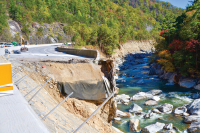Rivers in WNC bear native names
 Long before the first Europeans arrived, the Cherokees developed ceremonials that focused on the spiritual power of running water. When ethnologist James Mooney arrived on the Qualla Boundary in the summer of 1887, those beliefs, which he described as the “The Cherokee River Cult,” were still in place.
Long before the first Europeans arrived, the Cherokees developed ceremonials that focused on the spiritual power of running water. When ethnologist James Mooney arrived on the Qualla Boundary in the summer of 1887, those beliefs, which he described as the “The Cherokee River Cult,” were still in place.
Mooney observed that purification in moving water was an integral part of day-to-day life and tribal ceremony. Water dipped from chosen waterfalls was employed on special occasions. Even in winter whole families would go to water at daybreak and stand in prayer before plunging into the cleansing element together.
To this day, creeks and rivers are the lifeblood of our mountains. We locate ourselves in the universe by their names, thinking of our families as being residents of Fires Creek, Greens Creek, Lands Creek, Jonathans Creek, Barkers Creek, and so on.
And our major rivers form the large watersheds that to a great extent define our mental geography. Murphy is in the Hiwassee watershed. Robbinsville is in the Cheoah watershed. Franklin is in the Little Tennessee watershed. And so on.
I’m often surprised to find that even lifelong residents of various watersheds with which they closely identify don’t know the origins of the names for “their” rivers. The aquatic nomenclature for the river systems from Murphy to Asheville is not complex, but it is dominated by Cherokee designations.
Hiwassee is the anglicized form of the Cherokee word “ayuhwas-si,” which means “a meadow” or “lush open area.” The name of the town in north Georgia is spelled “Hiawassee.”
Related Items
Cheoah is the anglicized form of the Cherokee word “cheeohwa,” which means “otter.”
The Little Tennessee River is, of course, a major tributary of the Tennessee River. “Tennessee” is the anglicized form of the Cherokee word “Tanasi,” the name of an important Cherokee village once situated on the Little Tennessee. The Little Tennessee has two major tributaries. I’ve encountered several versions of what “Nantahala” means, but it seems best to stick with the well-known “Land of the Noonday Sun.” “Tuckaseege” (also spelled with two “e’s” at the end or with an “i” after the first “e” and two “e’s” at the end) is said to be the anglicized form of the Cherokee word “tsiksitsi,” which reputedly means “crawling terrapin.” But the Cherokee names for water turtle (“saligugi”), terrapin (“daksi”), and softshell turtle (“ulanawa” or its lexical variant “klanawa”) don’t seem applicable in this context.
Chattooga is the anglicized form of the Cherokee word “chatawga,” which means “chicken.” I don’t know when the Cherokees first laid eyes on a chicken. Maybe DeSoto brought a few with him in 1541? And I certainly don’t know why they would name a river after a domesticated fowl. There was a British officer named, as I remember, “Col. Chicken,” who ventured into Cherokee country.
I assume that the Pigeon is so-named after the native passenger pigeon (now extinct) rather than the domesticated rock dove, which is also commonly known as a pigeon.
Swannanoa is the anglicized form of the Cherokee word “Suwali-nunna,” which means “trail of the Suwali tribe.” The anthropologist James Mooney noted that this trail ran from Cherokee lands “to the Suwali tribe living east of the mountains.” They were also known as the Sara Indians
And we conclude with French Broad. Many visitors to the region are disappointed to learn that the name refers to “a wide river that leads to the French territories.”
George Ellison wrote the biographical introductions for the reissues of two Appalachian classics: Horace Kephart’s Our Southern Highlanders and James Mooney’s History, Myths, and Sacred Formulas of the Cherokees. In June 2005, a selection of his Back Then columns was published by The History Press in Charleston as Mountain Passages: Natural and Cultural History of Western North Carolina and the Great Smoky Mountains. Readers can contact him at P.O. Box 1262, Bryson City, N.C., 28713, or at This email address is being protected from spambots. You need JavaScript enabled to view it..









